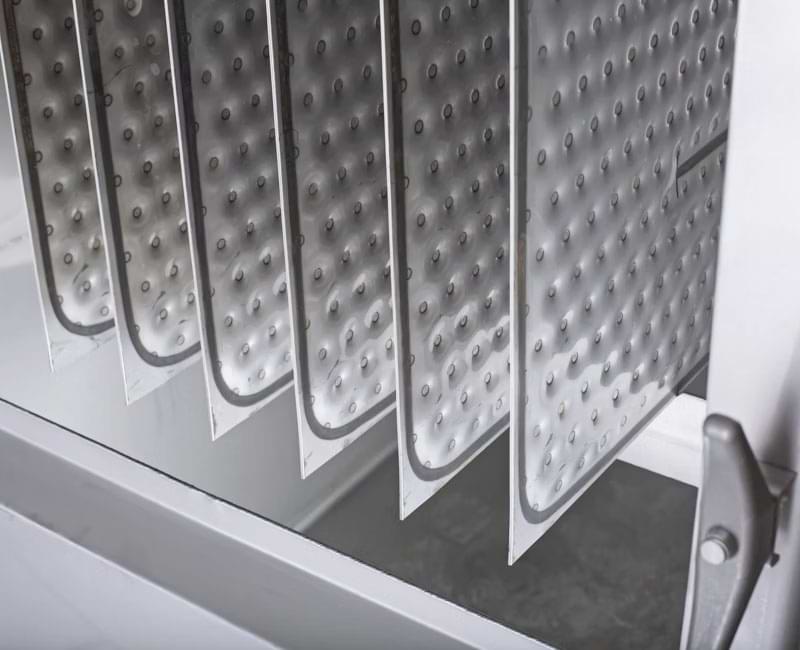Selecting the Right Falling Film Chiller
Choosing the proper falling film chiller begins with understanding your process requirements and matching them to the evaporator’s capabilities. These chillers excel in high-capacity, stable load applications and provide energy-efficient cooling with reduced refrigerant volume and excellent thermal control.
- Capacity Planning: Determine cooling load in kW or RT and size the chiller 10–20% above calculated demand for reliability.
- Operating Range: Ideal for chilled water temperatures between 5°C and 12°C; not recommended for sub-zero applications.
- Energy Efficiency: Seek high COP values (=5 for water-cooled systems) and integrated part-load performance (IPLV).
- System Type: Choose between air-cooled for water-limited environments and water-cooled for higher efficiency.
- Construction: Stainless steel materials and uniform feed distributors ensure corrosion resistance and even film formation.
- Maintenance: Simplified access and automated controls enhance reliability and serviceability in demanding industrial environments.

Understanding Falling Film Chillers
Efficient Cooling for Industrial Processes
Falling film chillers use gravity to distribute refrigerant as a thin, uniform film across evaporator tubes, maximizing surface area for heat transfer while minimizing refrigerant charge. This design offers faster temperature pull-down, reduced compressor work, and superior performance for heat-sensitive applications such as dairy, beverage, and chemical processing.
- High Thermal Efficiency and Low Refrigerant Volume
- Excellent for Stable, Continuous Loads
- Compact Design with Vertical Tube Bundle
- Reduced Operating Costs via Energy Savings
- Low Maintenance and Easy Access Cleaning
- Compatible with Low-GWP Refrigerants
Key Criteria for Selecting a Falling Film Chiller
Proper chiller selection ensures efficiency, reliability, and product quality. Start with cooling capacity and temperature range—most systems perform best for outlet temperatures between 5°C and 12°C. Evaluate compressor type, COP, and refrigerant compatibility to ensure sustainable and cost-effective operation. Falling film chillers are most effective in large, steady-load environments exceeding 100 RT.
Prioritize models with advanced heat transfer designs, corrosion-resistant materials, and automated controls to optimize system stability. Compact footprints and modular construction make these units suitable for tight plant layouts requiring high performance and ease of maintenance.
Energy Efficiency and Performance
High-performance falling film chillers achieve Coefficients of Performance (COP) above 5 for water-cooled configurations. Thin-film evaporation improves heat transfer coefficients and reduces refrigerant charge by up to 20% compared to flooded systems. Variable-speed drives (VSDs) further enhance part-load efficiency.
Material and Refrigerant Selection
Stainless steel construction ensures longevity and corrosion resistance, especially in humid or chemical environments. Select systems compatible with eco-friendly refrigerants like R-1234ze or ammonia (R-717) for reduced environmental impact and compliance with modern regulations.
Design and Space Considerations
Falling film chillers require vertical clearance but occupy minimal floor area. Tube bundles with small diameters and precise distributor systems ensure uniform film coverage and stable operation. Balance system height with available headroom and access needs.
Maintenance and Automation
Simplified access for inspection and cleaning, combined with automated control systems, minimizes downtime and enhances operational reliability. Even distribution across tubes is crucial—periodic checks ensure long-term performance and prevent dry-out or scaling.
Lifecycle Costs and ROI
Although initial investment may be higher, falling film chillers offer lower lifecycle costs due to 20–30% energy savings compared to traditional flooded designs. When properly maintained, they provide long service life and quick payback through operational efficiency.
When to Choose Falling Film Chillers
Select falling film chillers over flooded types when efficiency, lower refrigerant charge, and gentle thermal handling are priorities. Compared to plate or rising film designs, they deliver superior performance for large-scale, continuous applications and temperature-sensitive materials.
Common FAQs
A falling film chiller uses a vertical heat exchanger where refrigerant flows as a thin film down the inside of tubes under gravity. This enhances heat transfer efficiency, allowing for faster, more even cooling with reduced refrigerant charge. The chilled fluid, typically water or glycol, absorbs heat from the process side, making it ideal for applications needing precise temperature control and high throughput.
Selection should be based on process load, temperature range, efficiency, and compatibility. Evaluate cooling capacity in RT or kW, target outlet temperature, and fluid characteristics. Check COP ratings, available refrigerants, and construction materials. Stainless steel and ammonia or R-1234ze refrigerants are often preferred for efficiency and environmental performance.
- High heat transfer efficiency and reduced energy use
- Lower refrigerant charge (up to 30% less than flooded systems)
- Gentle cooling for heat-sensitive materials
- Compact design and lower operational noise
- Fast pull-down times and stable temperature control
Falling film chillers are less suited for sub-zero or highly variable loads. Uneven film formation can reduce efficiency, and viscous or scaling fluids may require additional recirculation. They also require sufficient vertical clearance for installation and maintenance.
With proper maintenance and operation, a falling film chiller can last 15–25 years. Routine cleaning, inspection, and monitoring of distribution uniformity are key to ensuring long-term reliability and efficiency.
Maintenance includes periodic cleaning to prevent scaling, checking distributors for even flow, and monitoring refrigerant charge and compressor performance. Automated control systems help maintain film stability and reduce human error.


